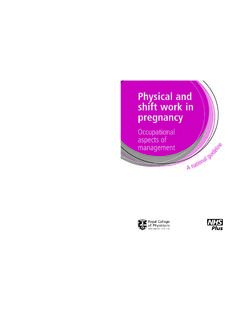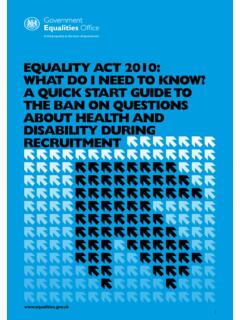Transcription of Advice for employers on workplace adjustments for mental ...
1 Advice for employers on workplace adjustments for mental health conditions At any one time, one in six adults1 will be experiencing a mental health condition. It is crucial that employers are playing a full part in supporting job retention and return to work for people with such conditions. In this document we use the term mental health condition to refer to early signs of stress as well as medically diagnosed conditions such as depression, schizophrenia or bipolar disorder. In many cases simple and cost-effective workplace adjustments can make a big difference and can allow people with mental health conditions to keep in touch with the working world and live healthy and productive lives. The adjustment needed could be a change in practice or workload. These guidance notes are intended to help employers think through the kinds of adjustments at work which they can make for people with mental health conditions. They include practical Advice and links to other resources which might help them to support job retention and return to work .
2 The key thing to remember is that everyone s experience of mental ill health is different so two people with a diagnosis of depression may have very different symptoms and need different adjustments . This may seem complex, but often the person will be the expert on their condition and know their own support needs. Why should an employer make adjustments ? There are a number of reasons why employers should take steps to make adjustments for people with mental health conditions. From a regulatory perspective, the Equality Act ( 2010 ) outlines an employer s duty to make reasonable adjustments for people with disabilities in order to ensure that they have the same access to everything that involves gaining or keeping employment as a non-disabled person. According to the Act a person is defined as disabled if they have a mental or physical impairment that has a substantial long term ( more than 12 months) effect on their normal day to day activities. A person is also protected under the Act if they have been affected in this way in the past but have been well for some time.
3 From a business perspective, proactive management of employees mental and physical health can produce a range of benefits, including reduction of sickness absence, greater staff engagement and productivity, and reduced staff turnover, recruitment and costs. Making a few small adjustments to enable a member of staff to continue doing their job is far less expensive than the costs incurred through recruiting and training a new employee. Most adjustments cost nothing and according to The Equality and Human Rights Commission, the average cost is just 752. There are best practice arguments too. Evidence has shown that good work is beneficial for mental health and well-being and that - for people with a mental health condition - work can aid recovery (Waddell and Burton, 2006). However, stigma and lack of understanding, as well as lack of knowledge about how to support people in the workplace , means that a large number of people with mental health conditions remain unemployed.
4 Anyone who wishes to work should be able to do so through making work more accessible. employers who attach priority to inclusiveness and their wider social responsibilities will wish to ensure that both their policies 1 Office for National Statistics (2000), Psychiatric morbidity among adults living in private households in Great Britain. 2 Equality and Human Rights Commission, Top Tips for Small employers : A guide to employing disabled people and practices maximise opportunities for people with mental health conditions to stay in, or return to, work . What is a workplace adjustment? A workplace adjustment is a change or adjustment unique to a person s needs that will enable them to do their job. A person is eligible for adjustments termed reasonable if they are legally defined as disabled (see definition in previous section). A reasonable adjustment is an adjustment to the workplace or work practices that is effective for the employee without being too disruptive, costly or impractical for the employer to provide.
5 Whilst there is a particular imperative for employers to consider reasonable adjustments for those legally defined as disabled, it is good practice to consider workplace adjustments for anyone who is affected by a mental health condition or stress at work . When to make adjustments The adjustments that an employer can make are dependent on the employee or candidate disclosing about their health condition in the first place or at least be willing to discuss their needs. employers have a duty to ensure that workplace adjustments are applied at every stage of employment including recruitment, induction, training and development and return to work . Agreeing adjustments Putting the individual at the centre of the discussion is vital for agreeing workplace adjustments in order to understand and meet their specific needs. Using the Advice and guidance of other professionals such as the individual s GP or asking for support from occupational health , Human Resources or Access to work (see below) can also be invaluable in finding solutions.
6 The following tools can help as a starting point for discussions or can be used to record agreements of adjustments : Fit for work Statement ( Fit note ) an individual s GP advises on the effects of their health condition and what changes you as an employer could make to help the individual return to work as part of their recovery. Tailored adjustment agreement this is a live document recording the reasonable adjustments that have been agreed. It can help minimise the need to re-negotiate adjustments in the future and provide a basis for discussion in further meetings. Staying Well Plans, WRAP, work , health and wellbeing promotion plans these are completed by an individual to help them and you to understand how they are when they are well, the signs when they are becoming unwell, and the best way to help them if they do become ill. Access to work is a government-run programme delivered by Jobcentre Plus to help overcome barriers that disabled people come across in getting into or retaining employment.
7 The programme provides Advice , a possible assessment of a persons disability needs in the workplace , and if required, a financial grant towards the cost of any necessary support. They have recently introduced a new mental health Support Service. It is provided where the employee requires support or adaptations beyond those reasonable adjustments which an employer is legally obliged to provide under the Equality Act 2010 . Information about the programme and how to access support can be found on the Direct Gov website. Practical examples of workplace adjustments Being flexible and creative is important when considering solutions. Below are examples which could act as prompts for line managers and employees exploring these issues together. Working hours or patterns - Take a flexible approach to start/finish times and/or shift patterns - Allow use of paid or unpaid leave for medical appointments - Phase the return to work , offering temporary part-time hours - Equal amount of break time, but in shorter, more frequent chunks - Allow someone to arrange their annual leave so that is spaced regularly throughout the year - Allow the possibility to work from home at times - Temporary reallocation of some tasks Physical environment - Minimise noise providing private office/room dividers/partitions, reducing pitch or volume of telephone ring tones - Provide a quiet space for breaks away from the main workspace - Offer a reserved parking space - Allow for increased personal space - Move workstation to ensure for example that someone does not have their back to the door.
8 Support with workload - Increase frequency of supervision - Support someone to prioritise their work - Allow the individual to focus on a specific piece of work - Consider job sharing Support from others - Provide a job coach - Provide a buddy or mentor - Provide mediation if there are difficulties between colleagues Gail s story Gail is 44 and works as a social worker for a local authority, managing a case load of clients. She has suffered from anxiety and depression in the past. She recently told her manager that she is feeling very anxious and has been suffering from panic attacks. She has been finding it hard to concentrate on writing client reports when she is back in the busy, open-plan office and has difficulty prioritising her workload. Gail has been to see her GP and is now receiving therapy from the practice s counsellor. There is no capacity within the team for Gail s caseload to be reduced but her manager suggests that they increase her monthly supervisions to weekly to discuss client cases and help Gail to prioritise her workload.
9 Gail s manager also reminds her that she can book a quiet room for a couple of days a week so that she can concentrate on report writing an option available to all employees. As Gail already has a flexitime agreement, her manager agrees for her to come into work later on the day of her therapy. Gail and her manager agree to review these adjustments in a couple of week s time to see if they are working. Good practice for applying workplace adjustments Have an open, honest and practical conversation with the person about how their mental health condition impacts their work and what adjustments can be made. Ask the individual what they need they are often the best experts of managing their condition. Focus on what the person can do not what they can t. Tailor adjustments to the specific needs and abilities of the individual be creative. Be flexible as some mental health conditions can be episodic. It may be more helpful to agree adjustments that can be implemented as and when required and revoked when not.
10 Agree the adjustments which are appropriate for the organisation and the individual. Be realistic about what you can offer. If you are unsure, consult your Human Resources department or the ACAS helpline may be able to offer you guidance. Regularly review the adjustments to ensure they are working and are still appropriate. With the permission of the individual communicate the adjustments to other team members to alleviate perceptions of favourable treatment. Consider the wider organisational context in which the adjustments are being made and whether or not they can be offered to all staff. Always take Advice (as above) where you re not sure what to do. Creating a supportive environment workplace adjustments will only succeed if they occur in a supportive, understanding environment. Whilst not all mental health conditions occur as a result of work , taking steps to create a psychologically healthy workplace can help mitigate the potential negative impact of work on employees mental health .




